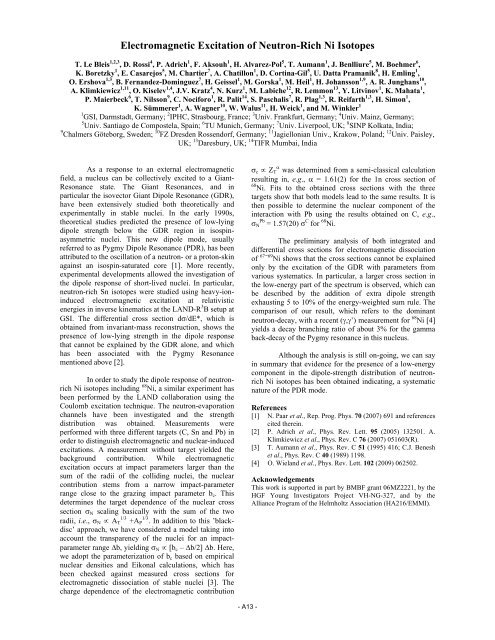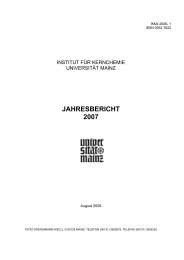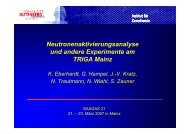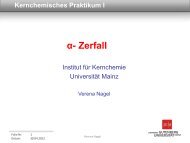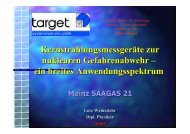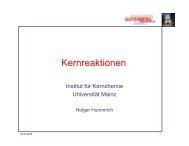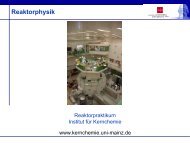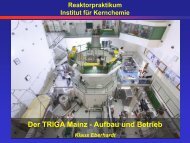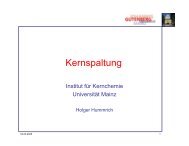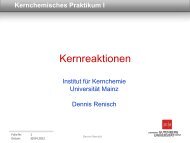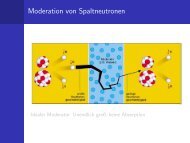institut für kernchemie universität mainz jahresbericht 2009
institut für kernchemie universität mainz jahresbericht 2009
institut für kernchemie universität mainz jahresbericht 2009
You also want an ePaper? Increase the reach of your titles
YUMPU automatically turns print PDFs into web optimized ePapers that Google loves.
Electromagnetic Excitation of Neutron-Rich Ni Isotopes<br />
T. Le Bleis 1,2,3 , D. Rossi 4 , P. Adrich 1 , F. Aksouh 1 , H. Alvarez-Pol 5 , T. Aumann 1 , J. Benlliure 5 , M. Boehmer 6 ,<br />
K. Boretzky 1 , E. Casarejos 5 , M. Chartier 7 , A. Chatillon 1 , D. Cortina-Gil 5 , U. Datta Pramanik 8 , H. Emling 1 ,<br />
O. Ershova 1,3 , B. Fernandez-Dominguez 7 , H. Geissel 1 , M. Gorska 1 , M. Heil 1 , H. Johansson 1,9 , A. R. Junghans 10 ,<br />
A. Klimkiewicz 1,11 , O. Kiselev 1,4 , J.V. Kratz 4 , N. Kurz 1 , M. Labiche 12 , R. Lemmon 13 , Y. Litvinov 1 , K. Mahata 1 ,<br />
P. Maierbeck 6 , T. Nilsson 9 , C. Nociforo 1 , R. Palit 14 , S. Paschalis 7 , R. Plag 1,3 , R. Reifarth 1,3 , H. Simon 1 ,<br />
K. Sümmerer 1 , A. Wagner 10 , W. Walus 11 , H. Weick 1 , and M. Winkler 1<br />
1 GSI, Darmstadt, Germany; 2 IPHC, Strasbourg, France; 3 Univ. Frankfurt, Germany; 4 Univ. Mainz, Germany;<br />
5 Univ. Santiago de Compostela, Spain; 6 TU Munich, Germany; 7 Univ. Liverpool, UK; 8 SINP Kolkata, India;<br />
9 Chalmers Göteborg, Sweden; 10 FZ Dresden Rossendorf, Germany; 11 Jagiellonian Univ., Krakow, Poland; 12 Univ. Paisley,<br />
UK; 13 Daresbury, UK; 14 TIFR Mumbai, India<br />
As a response to an external electromagnetic<br />
field, a nucleus can be collectively excited to a Giant-<br />
Resonance state. The Giant Resonances, and in<br />
particular the isovector Giant Dipole Resonance (GDR),<br />
have been extensively studied both theoretically and<br />
experimentally in stable nuclei. In the early 1990s,<br />
theoretical studies predicted the presence of low-lying<br />
dipole strength below the GDR region in isospinasymmetric<br />
nuclei. This new dipole mode, usually<br />
referred to as Pygmy Dipole Resonance (PDR), has been<br />
attributed to the oscillation of a neutron- or a proton-skin<br />
against an isospin-saturated core [1]. More recently,<br />
experimental developments allowed the investigation of<br />
the dipole response of short-lived nuclei. In particular,<br />
neutron-rich Sn isotopes were studied using heavy-ioninduced<br />
electromagnetic excitation at relativistic<br />
energies in inverse kinematics at the LAND-R 3 B setup at<br />
GSI. The differential cross section dσ/dE*, which is<br />
obtained from invariant-mass reconstruction, shows the<br />
presence of low-lying strength in the dipole response<br />
that cannot be explained by the GDR alone, and which<br />
has been associated with the Pygmy Resonance<br />
mentioned above [2].<br />
In order to study the dipole response of neutronrich<br />
Ni isotopes including 68 Ni, a similar experiment has<br />
been performed by the LAND collaboration using the<br />
Coulomb excitation technique. The neutron-evaporation<br />
channels have been investigated and the strength<br />
distribution was obtained. Measurements were<br />
performed with three different targets (C, Sn and Pb) in<br />
order to distinguish electromagnetic and nuclear-induced<br />
excitations. A measurement without target yielded the<br />
background contribution. While electromagnetic<br />
excitation occurs at impact parameters larger than the<br />
sum of the radii of the colliding nuclei, the nuclear<br />
contribution stems from a narrow impact-parameter<br />
range close to the grazing impact parameter bc. This<br />
determines the target dependence of the nuclear cross<br />
section σN scaling basically with the sum of the two<br />
radii, i.e., σN ∝ AT 1/3 +AP 1/3 . In addition to this ’blackdisc’<br />
approach, we have considered a model taking into<br />
account the transparency of the nuclei for an impactparameter<br />
range Δb, yielding σN ∝ [bc – Δb/2] Δb. Here,<br />
we adopt the parameterization of bc based on empirical<br />
nuclear densities and Eikonal calculations, which has<br />
been checked against measured cross sections for<br />
electromagnetic dissociation of stable nuclei [3]. The<br />
charge dependence of the electromagnetic contribution<br />
σc ∝ ZT α was determined from a semi-classical calculation<br />
resulting in, e.g., α = 1.61(2) for the 1n cross section of<br />
68 Ni. Fits to the obtained cross sections with the three<br />
targets show that both models lead to the same results. It is<br />
then possible to determine the nuclear component of the<br />
interaction with Pb using the results obtained on C, e.g.,<br />
σN Pb = 1.57(20) σ C for 68 Ni.<br />
The preliminary analysis of both integrated and<br />
differential cross sections for electromagnetic dissociation<br />
of 67−69 Ni shows that the cross sections cannot be explained<br />
only by the excitation of the GDR with parameters from<br />
various systematics. In particular, a larger cross section in<br />
the low-energy part of the spectrum is observed, which can<br />
be described by the addition of extra dipole strength<br />
exhausting 5 to 10% of the energy-weighted sum rule. The<br />
comparison of our result, which refers to the dominant<br />
neutron-decay, with a recent (γ,γ’) measurement for 68 Ni [4]<br />
yields a decay branching ratio of about 3% for the gamma<br />
back-decay of the Pygmy resonance in this nucleus.<br />
Although the analysis is still on-going, we can say<br />
in summary that evidence for the presence of a low-energy<br />
component in the dipole-strength distribution of neutronrich<br />
Ni isotopes has been obtained indicating, a systematic<br />
nature of the PDR mode.<br />
References<br />
[1] N. Paar et al., Rep. Prog. Phys. 70 (2007) 691 and references<br />
cited therein.<br />
[2] P. Adrich et al., Phys. Rev. Lett. 95 (2005) 132501. A.<br />
Klimkiewicz et al., Phys. Rev. C 76 (2007) 051603(R).<br />
[3] T. Aumann et al., Phys. Rev. C 51 (1995) 416; C.J. Benesh<br />
et al., Phys. Rev. C 40 (1989) 1198.<br />
[4] O. Wieland et al., Phys. Rev. Lett. 102 (<strong>2009</strong>) 062502.<br />
Acknowledgements<br />
This work is supported in part by BMBF grant 06MZ2221, by the<br />
HGF Young Investigators Project VH-NG-327, and by the<br />
Alliance Program of the Helmholtz Association (HA216/EMMI).


